If you’re looking for OKR (Objectives and Key Results) software to set, track, and hit your strategic goals faster, there are plenty of options out there.
But finding the best OKR management solution for your team isn’t always a straightforward process. Many organizations don’t know what to consider and often only discover problems after implementing a new platform.
To help you choose, we've compiled our top ten picks for the best OKR software in 2025 based on comparison sites like G2 and Capterra:
Below you can read our guide on how to choose the right OKR tool or skip straight to our overview of the top vendors.
How To Choose The Right OKR Software For Your Organization?
If you're getting lost in the sea of available OKR software solutions, picking the best platform can be overwhelming. What makes you confident that it will meet your needs before you commit? The last thing you want is to spend the company's budget on a software tool that doesn't fit your needs and lands you in hot water with the CFO.
Before you commit to OKR software, consider the following:
1. Ease of use
OKR platform must be user-friendly to ensure employee engagement, rapid implementation, and adoption of the new tool. If using your OKR tool is a challenge or the UI looks like it's from the late 90s, your team members won't engage.
Some key questions you should ask:
- Are the platform’s functionality and design intuitive? Is it easy to use and easy to navigate?
- Does the OKR tool require my team to switch between different platforms?
- How long will it take my team to get up and running with this OKR tool?
2. Price
Investing in a particular OKR platform is a long-term commitment. Choosing a solution that offers tangible benefits for the price you're paying is vital. Remember to weigh up the cost of the OKR tool against the features and functionality it provides. Determine how many team members will use the tool and the possibility of expanding your user base.
Some key questions you should ask:
- Does the platform offer a trial version, free plan, or demo? Can you try it out before you commit?
- How does pricing work? What is the cost of adding more users and features?
- Are there any hidden fees for extra customer support?
3. Reporting and tracking
Tracking and reporting are fundamental to keeping OKRs and strategy execution on track. Look at how you can use the OKR software to present and view data. What other tracking and reporting functions does it offer? Does it have different use cases, or is it purely an OKR management tool?
Some key questions you should ask:
- What kind of metrics can we track? Can we add KPIs to OKRs and integrations with other business tools for real-time automated updates?
- How does it let me monitor, track, and report on results? Does it offer features like real-time dashboards, in-app updates, and notifications?
- How customizable is it? Does it have options like filters and drill-down capabilities?
- Does it allow automation of the reporting process?
4. Performance
A buggy or slow platform will reduce the effectiveness of your planning, monitoring, and reporting. Your OKR tool must be reliable, fast, and empowering. Investigate and do your research! Find out what other users say about the product before signing up.
Some key questions you should ask:
- Have users reported performance issues with the tool’s functionality or capabilities?
- What performance issues have they reported?
5. Integrations
You'll want an OKR solution that integrates with your existing software stack. Go through the integrations listed on the website or contact the company to see what they offer.
Some key questions you should ask:
- Does the OKR tool offer integrations with our existing business tools?
- Is the process of integrating data from other sources straightforward? For example, do they offer native integrations, API-based integrations, or are they using Zapier?
- Are existing users complaining about integration capabilities?
6. Customer Support
Fast, responsive support is critical if an issue arises. Look at online reviews to see what people say about the type and quality of support with each OKR solution.
Some key questions you should ask:
- What level of support do they offer customers?
- Do they provide in-depth documentation, OKR templates, guides, training, and OKR coaching?
- Are the instructions clear?
7. Expectations
Keep in mind that the success of an OKR tool may differ depending on what you're looking for. Just because another company had a great experience with a specific tool doesn't guarantee the same for you. It's all about aligning your expectations and finding the right OKR software for YOUR organization.
For instance, some OKR tools are more focused on individual employee performance, which is awesome if you want to streamline HR processes. However, they might not provide the overall business strategy view you need.
On the other hand, there are tools that excel at tracking your business strategy, helping set team goals, and aligning employees with company goals for better execution. Yet, they might lack individual performance management features like 1:1 meetings, surveys, or feedback loops.
So, before making a decision, it's crucial to understand why you need an OKR software and what specific goals you want it to help you achieve.
Some key questions you should ask:
- What are specific goals that I want the OKR software to help me achieve?
- What features and functionalities do I require from an OKR tool to meet my organization's unique needs?
- How will I measure the success and effectiveness of the OKR software?
In addition to the above criteria, you need to figure out if your team or organization is ready for OKR solutions. You should be fine if you're already familiar with OKRs. However, if the idea of OKRs is new to your team, you should take the training process into account and consider whether the OKR framework is best suited to your organizational culture.
Now, let’s dig into the top providers one by one.
1. Cascade
.avif)
Cascade is the world’s #1 strategy execution platform, remediating the chaos of running a business to help you turn big goals into results, faster. Its powerful features and focus on the user make it a great tool for setting OKRs, collaborating together on shared goals, tracking performance, and reporting on results.
With Cascade, individuals or teams can set goals, track OKR progress, and align those OKRs with company objectives to ensure everyone is focused and working on what will move the needle. By achieving centralized strategy execution, every team member can see how their efforts contribute to the company's success.
On top of that, Cascade helps leadership teams deliver business results by giving them a top-level view of what’s happening across the organization, enabling them to make better decisions based on data.
Around the world, teams of all sizes rely on Cascade, including Johnson & Johnson, McClaren, and American Express. Using the platform, they automate their workflows and improve business performance by executing strategies faster.
Pros
- Drive strategic alignment: With Cascade’s Alignment Maps, you can create plans and sub-plans while staying aligned with the company’s strategy. Add team OKRs, individual OKRs, KPIs, and initiatives to each plan so you can track progress.
- Consolidate your metrics for enhanced focus: With Cascade’s Metrics Library you can centralize your business metrics directly from your business systems—data lakes, BI tools, or spreadsheets—and connect them to your OKRs and KPIs in your strategic plans.

- Ease of use: Cascade's intuitive user interface and functionality are a top selling point for many users. This simplicity makes it easy for anyone to leverage the potential of OKRs.
- Powerful automated reporting and tracking software: You’ll get live updates on the status of OKRs and KPIs to make crucial decisions faster. Save 10+ hours on manual reports through spreadsheets and PowerPoints with features like automated OKR tracking, customizable OKR dashboards, and drill-down reports.
.jpeg)
- Committed to A+++ customer support: Cascade’s support team is dedicated to top-notch customer service, and user ratings on third-party site reviews prove this.
🤓 There’s also plenty of support documentation in Cascade’s knowledge base and video library.
- Connect with other tools to visualize data in one place: With Cascade, you can integrate over 1,000 third-party apps directly into the platform, including:
- Collaboration tools—Microsoft Teams, Slack, Outlook
- Project management tools—Jira, Asana, Trello
- Other business tools—Tableau, SAP, Google Sheets, Excel, Salesforce
- Fully customizable to your specific needs: With Cascade, you aren't limited to the OKR framework alone. You can choose from different strategy execution frameworks or combine different frameworks into one that suits your organization's needs.
The Cascade platform supports the following strategy and goal-setting frameworks:
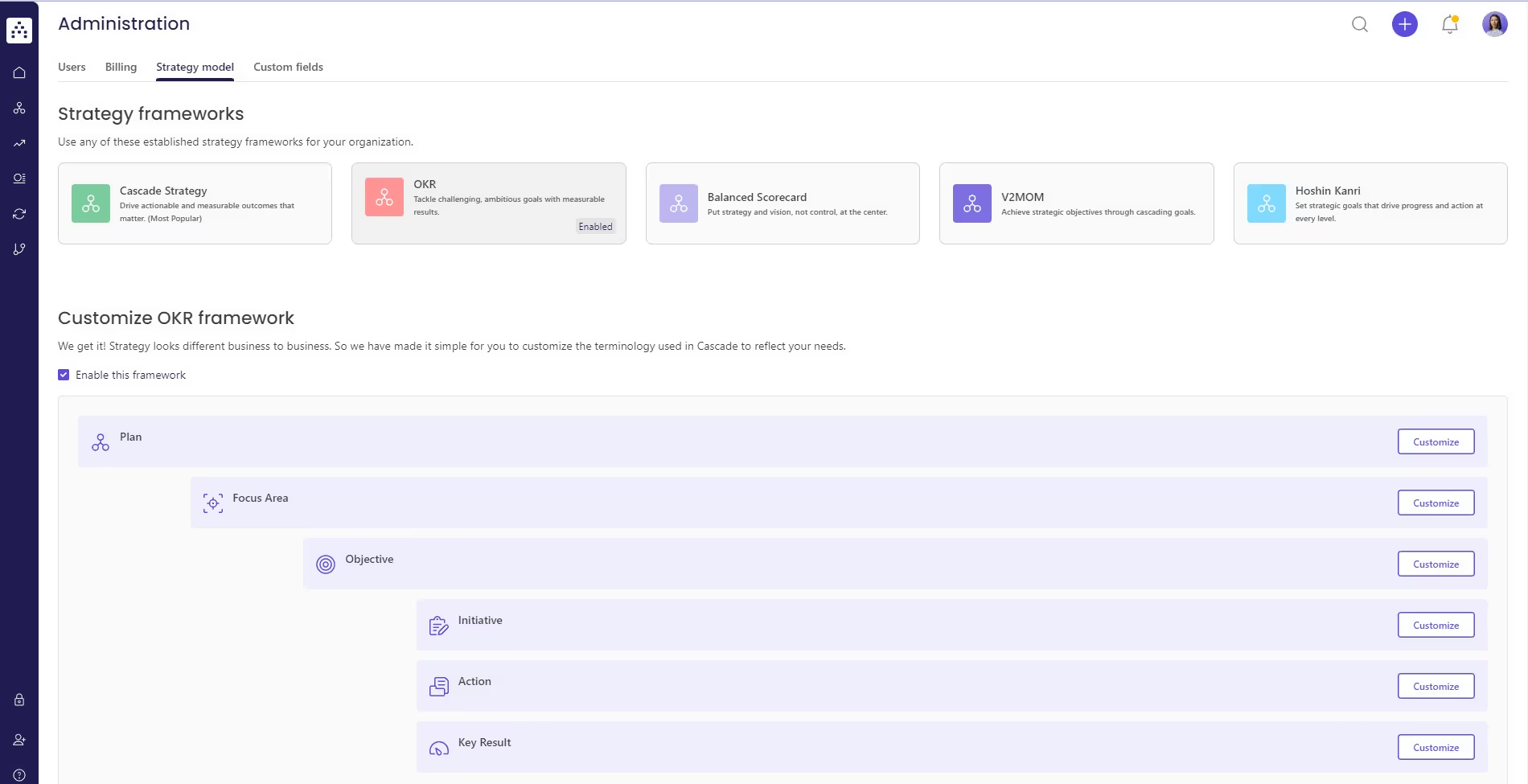
- Try it out before you commit: Simply give it a spin with a free account that you can cancel anytime. It's more than enough to get you started without any sales talk.
Cons
- Not an HR performance management software: While it has some pretty cool performance management features, such as employee engagement insights and individual dashboards to use during 1:1 reviews, that’s not its main use case. Cascade is built to help you collaborate and stay focused on main objectives, goals, and projects.
Pricing
- Free Forever Plan for smaller teams (up to 4 users)
- Essentials: Contact Sales for custom pricing
- Enterprise+: Contact Sales for custom pricing
Check out Cascade's pricing page for more details.
Want to see Cascade in action? 🚀
Book a free product tour with Cascade’s strategy experts.
2. Lattice

Lattice is a people success platform that helps you track employee performance and engagement. For example, they offer some pretty powerful automation capabilities that help HR and people teams manage the compensation process. It also has survey templates, goal management based on OKRs, performance reviews, and analytics about performance in real-time.
Due to its primary focus on managing individual goals, Lattice is a good choice for companies that want to monitor individual performance.
Pros
- Good choice for HR and people management teams
- Boost employee performance with career plans: Build and track long-term career goals with their Growth Plan feature.
- Pre-built templates: You can save time with pre-built templates like Remote One-on-One questions, Stay Interview, and Performance Improvement Plan Template.
Cons
- Mixed reviews on ease of use: While some users love Lattice for its simplicity, there are also some voices complaining about its confusing navigation.
- Focus on OKRs and individual performance: Their goal management system is restricted to OKR methodology and individual OKRs. This tool may not be the best fit for those who need to build strategic plans and assign OKRs for faster strategy execution.
Pricing
- Engagement plan: $4 user/month
- Grow plan: $4 user/month
- Compensation plan: $6 user/month
- Performance management + OKR & Goals plan: $11 user/month
- Multi-product and volume purchases available: you need to contact their sales team
3. Weekdone
.avif)
Weekdone's OKR software provides leaders with a comprehensive toolkit to set goals, monitor team performance, and streamline workflows. Its key features include alignment and linking, OKR Dashboards, and weekly check-ins. As a result, Weekdone is a popular choice for mid- to large-sized companies to improve their collaboration and track OKRs.
Pros
- Tracking and reporting: People love Weekdone’s real-time feedback feature for team members, automated quarterly status reports, and live dashboards to monitor outcomes.
- Wide range of integrations: Weekdone integrates with popular workplace tools, such as Asana and Teamwork, to help teams manage and track different OKR metrics.
Cons
- Confusing to set up and use: While some users stated that Weekdone was easy to use, some reviews mentioned it takes a lot of time to set it up and low team engagement as issues.
- May be missing key features: Several users mentioned they’d like to see more features, such as the ability to email reports, set recurring tasks, and add bi-weekly check-ins.
- Expensive tool: If you have only 3 users on your team, you’ll be fine with the free version. However, its paid plans start at $90 per month (billed annually) which makes it one of the costliest solutions on the market.
Pricing
- 3 User Package: Free.
- 10 User Package: $108
- 50 User Package: $420
- 100 User Package: $720
4. Profit.co

Profit.co OKR software offers businesses a highly customizable way of implementing OKR goal-setting for their organization. Profit.co is most popular with small businesses and mid-sized organizations in IT.
Profit.co's tools and features are great for performance management, task management, and employee engagement.
Pros
- Value for money: Affordable plans combined with powerful functionality and features make Profit.co a popular choice for smaller teams and mid-sized businesses.
- Support: Profit.co offers a high level of customer service. Several users have noted that customer support is fast, responsive, and knowledgeable.
Cons
- Steep learning curve: Profit.co’s complexity may prevent people without OKR training and prior experience from using it properly. Due to its many additional features and options, team members will need extra training to understand and use it effectively.
Pricing
- Launch (up to 5 users): Free
- Growth: $9 user/month—billed monthly
- Enterprise: Contact Sales
5. Perdoo
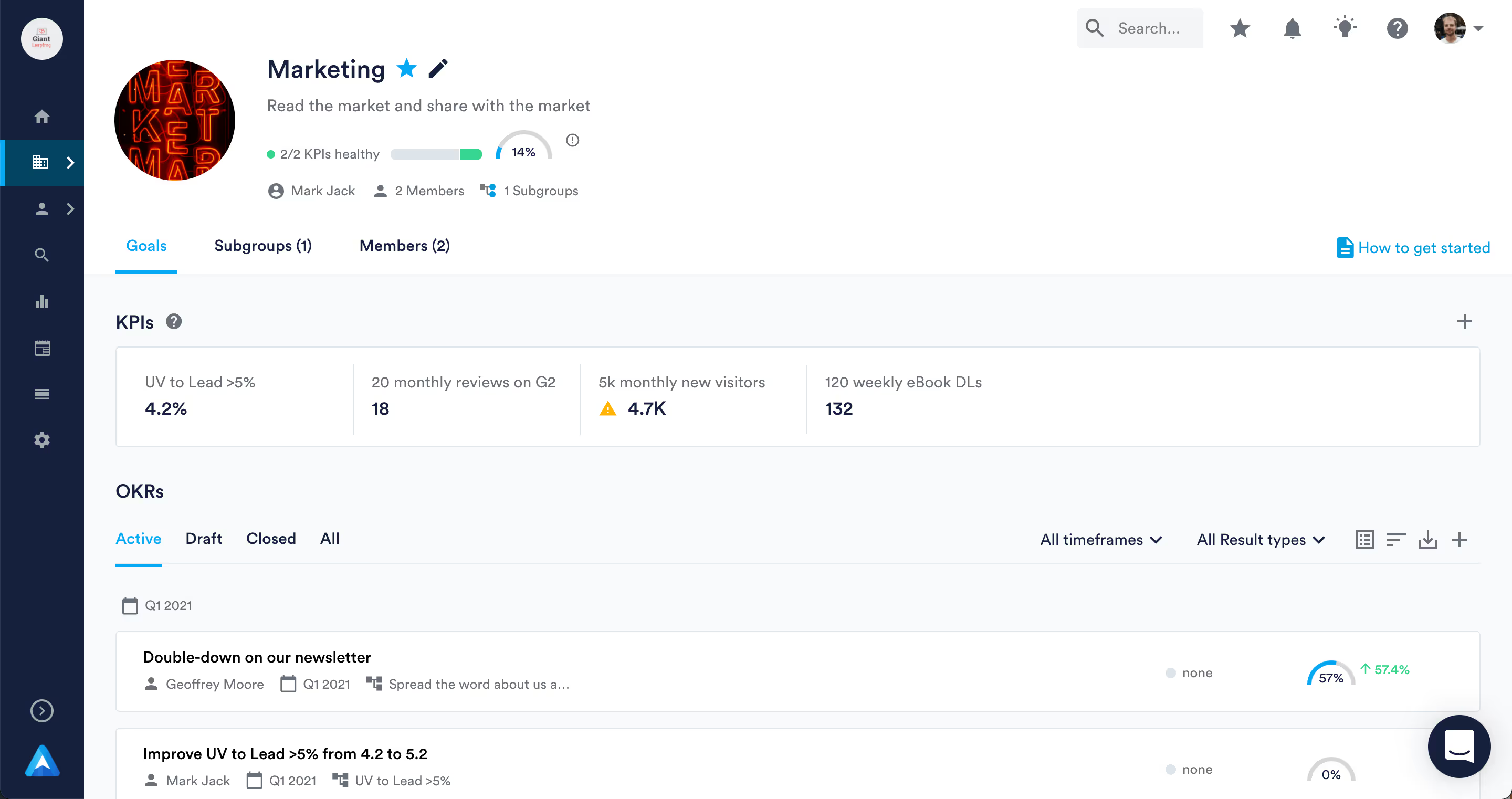
Perdoo is a simple OKR software solution that helps teams synchronize their long-term strategic goals and daily activities. Perdoo’s OKR software is popular among mid-sized organizations that operate in the pharmaceutical industry. However, any business looking to implement the OKR can use its features and capabilities.
Pros
- Purpose-built for OKRs: This makes Perdoo ideal for high-performing teams that want to plan objectives, track goals, and monitor progress by using OKRs.
- Support: Users of Perdoo rate the platform's OKR documentation and client support as excellent.
Cons
- Performance issues: Users mention occasional bugs and issues with features as a downside to using the platform.
- Steep learning curve: It may take time and training to get up to speed with the platform's features.
- Issues with reporting and tracking: Some users feel that Perdoo’s Roadmap feature is difficult to use and doesn’t provide enough information for a faster decision-making process.
Pricing
- Free (up to 5 users): $0
- Premium: $10 user/month
- Supreme: $12 user/month
6. Betterworks

Betterworks is an enterprise SaaS platform for OKR and employee management. The platform's focus is to help large businesses achieve company goals by closing the loop between people and business results. Betterworks' goal is the same as Lattice's: to make an all-in-one performance management tool for HR professionals.
Pros
- Performance management: Betterworks helps HR teams do their job efficiently through features like performance reviews, employee feedback surveys, coaching conversation templates, and OKR goal setting.
- Support documentation: They provide comprehensive e-learning materials and OKR coaching to improve team engagement and onboarding times.
Cons
- Difficult to use: Some users have stated that the Betterworks user interface is not straightforward and that it may take time to get up to speed with its various functions.
- Lack of integrations: Some reviewers mention they would like the platform to support more integrations with third-party apps.
- Free trial unavailable
Pricing
- Mid-Market (1,000-4,999 users): Contact Sales
- Enterprise (>5,000 users): Contact Sales
7. 15Five
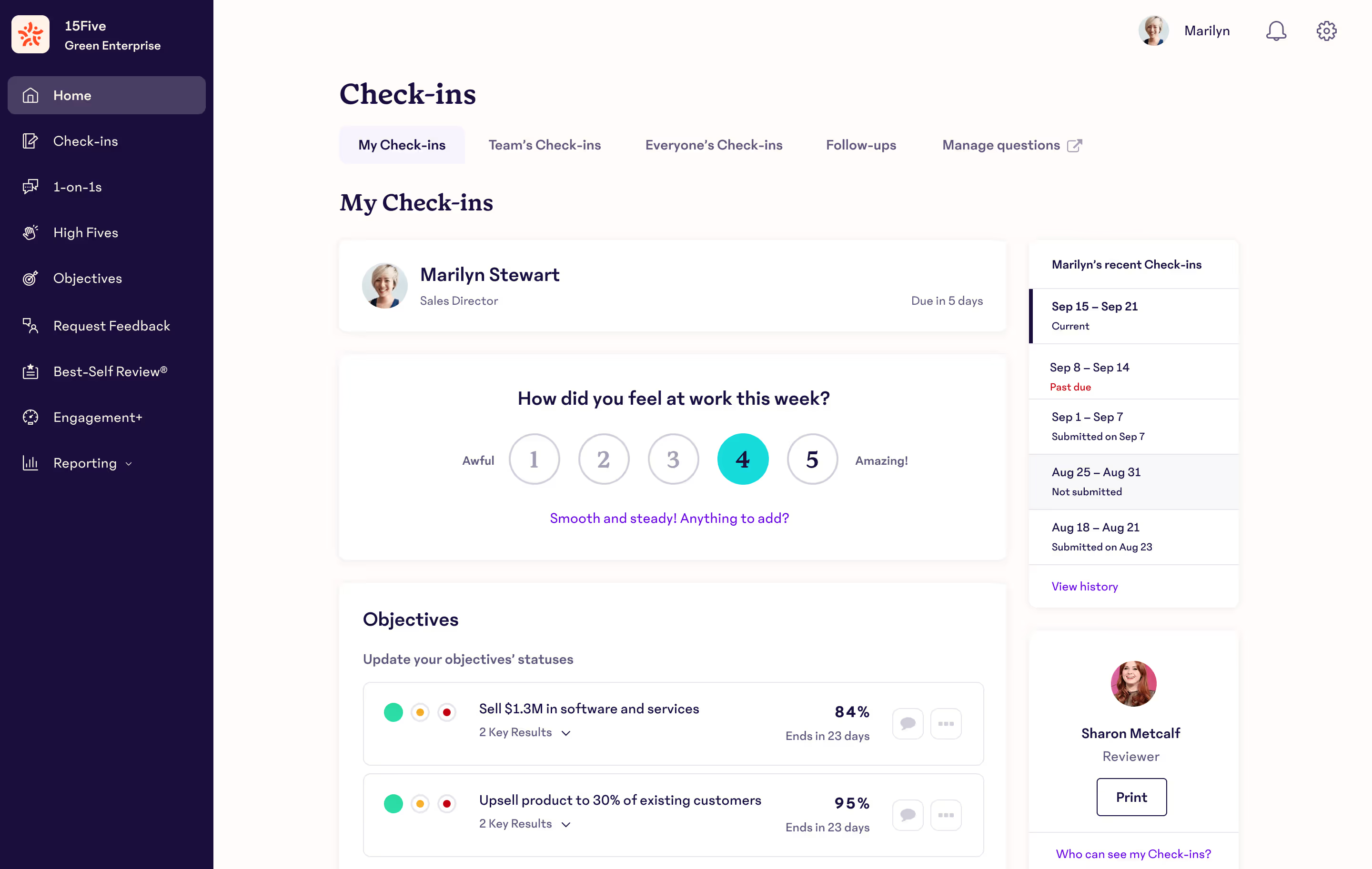
15Five is a performance management platform for HR leaders. The platform is focused on helping HR managers run their performance programs and make decisions based on a full view of an employee.
Pros
- Employee performance management: This platform offers a full suite of features helping HR managers to create a 360 view of their employees.
- Manager Training and Coaching Hub: You can create a coaching plan for each manager and track their journey to becoming a true leader.
- OKR-based goal management: They provide some features that help you track OKRs progress, run 1:1 performance reviews, and weekly check-ins.
Cons
- Steep learning curve: Some users pointed out that the OKR structure is difficult to understand.
- Goal-setting is limited to OKR methodology: If your organization decides OKRs are not a good fit for your processes, you may incur higher costs in the long run.
- HR focus: You won’t be able to generate reports with key business metrics to evaluate how your company’s and teams’ OKRs are affecting the bottom line.
Pricing
- Engage Plan: $4 user/month
- Perform Plan: $10 user/month
- Total Platform: $16 user/month
- Transform: Contact Sales
8. Aha!
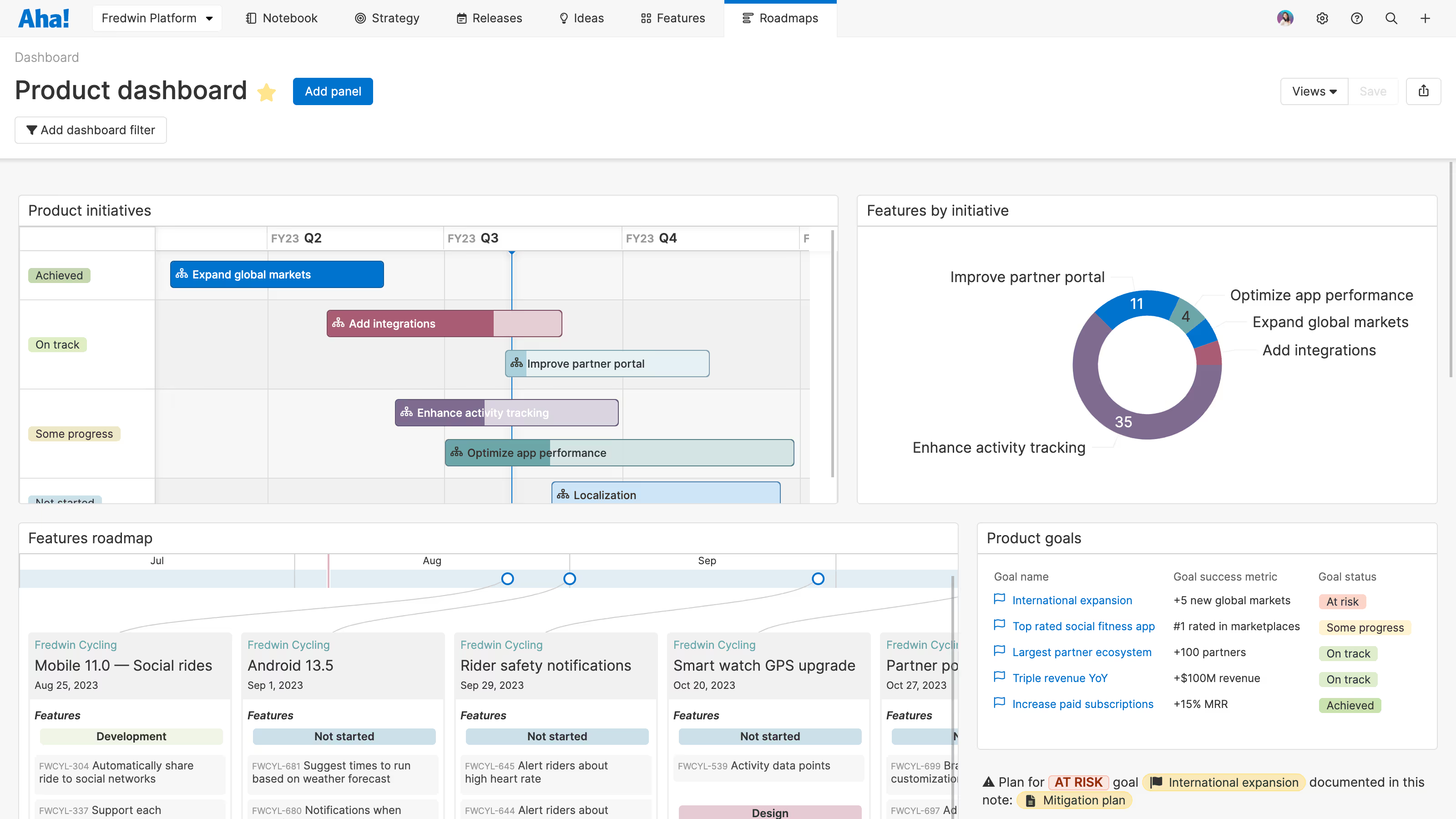
Aha! is a software specially designed to cover every step of the product development lifecycle. It includes several solutions like Aha! Roadmaps, Aha! Ideas, Aha! Notebooks, and Aha! Develop. It’s a great tool for product teams to streamline product development ideas into delivery focused on adding customer value.
Pros
- Simplifies Product Management lifecycle: Aha! provides a wide range of features that allow to streamline and integrate the product cycle into a cohesive workflow.
- Highly customizable: It’s a flexible tool that can be customized at nearly every level of the record hierarchy, allowing product teams to capture data and communicate via roadmaps to the wider organization.
- Great Product Concierge: There had been some complaints about Aha!’s customer service in the past years, but they were able to turn this around. Users now value their quick response times, besides the useful documentation and videos provided.
Cons
- Not intuitive for non-developers: Users mention that the system felt complicated for product managers or non-developer people in the team, and this led to them going back to the tools they feel more comfortable using.
- Costly solution for Gantt charts: Some say it doesn’t offer the capabilities and flexibility of other tools regarding a standard PMP portfolio or program management use case. The roadmaps are good, but the solution itself is costly for the value it brings.
- Steep learning curve: The UX/UI is not very intuitive and not self-explanatory so it can be hard to grasp for new users.
Pricing
- Aha! Notebooks: $9 user/month
- Aha! Develop: $9 user/month
- Aha! Ideas: $39 user/month
- Aha! Roadmaps: $59 user/month
9. Leapsome
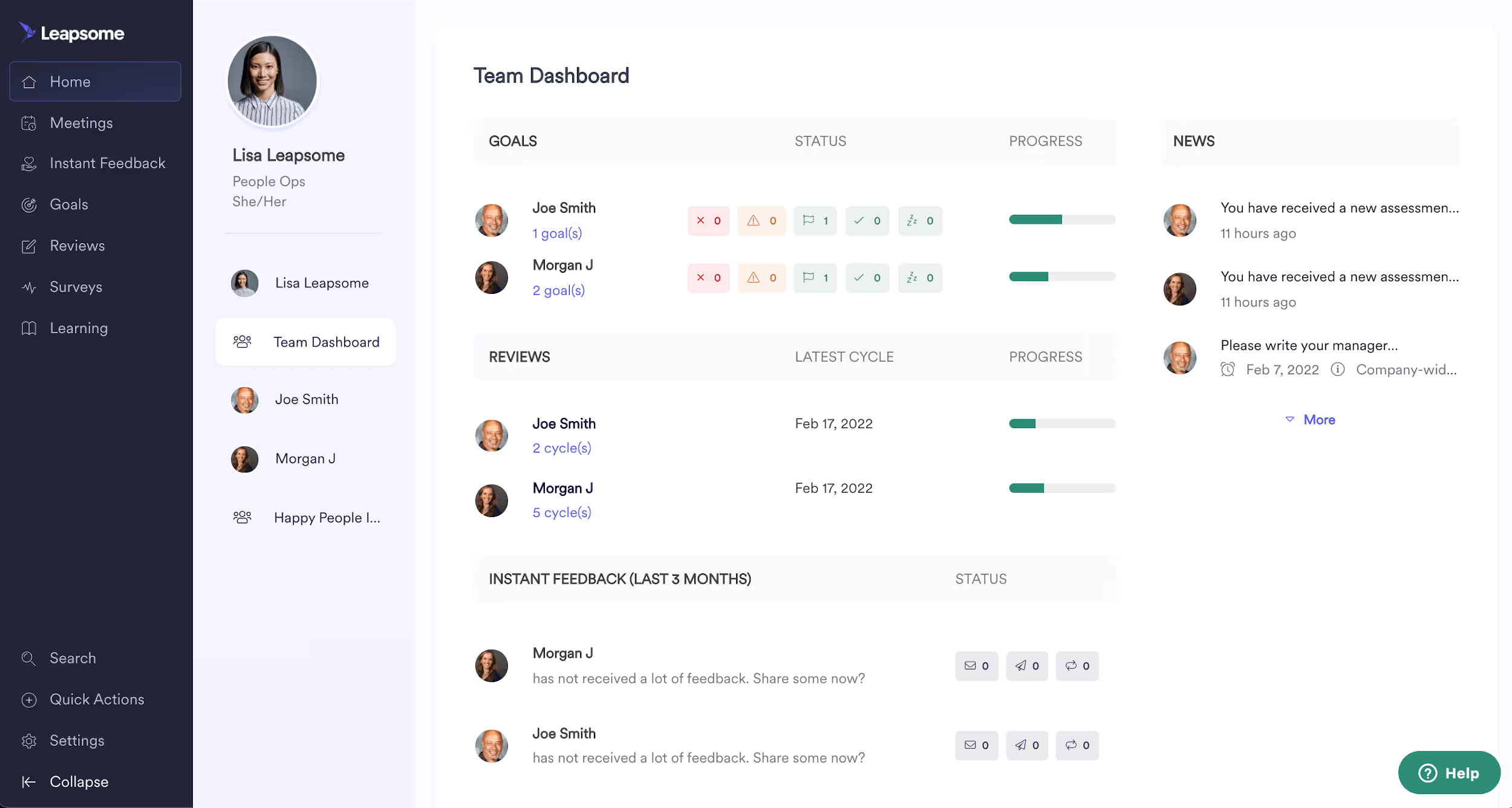
Leapsome is a People Enablement Platform specifically designed for HR teams to drive employee development, productivity, and engagement. Its functionalities include Progress Updates, Syncs 1:1, Reviews, Feedback, and Engagement Surveys.
Pros
- Great feedback features: What users seem to value the most, is how easy it is to manage 1:1s with team members and follow up. The “Instant Feedback” feature makes it simple and fast to give and receive feedback from others.
- On-demand training: Staff members can conveniently complete their training at their own pace to enhance their skill set on their own schedule.
Cons
- Complicated interface: There are some opinions about the UX being hard to grasp at first—especially for features like goal setting and monitoring. Some users describe it as not very intuitive to navigate.
- HR focus: If you’re looking for a tool that allows you to track individual OKRs and evaluate employee performance, this software might be great for your needs. If you’re looking for a tool to help you understand the performance of your business strategy as a whole, then there are features that you’ll miss.
Pricing
Pricing is not provided on their website; you’d have to contact sales.
10. Heartpace
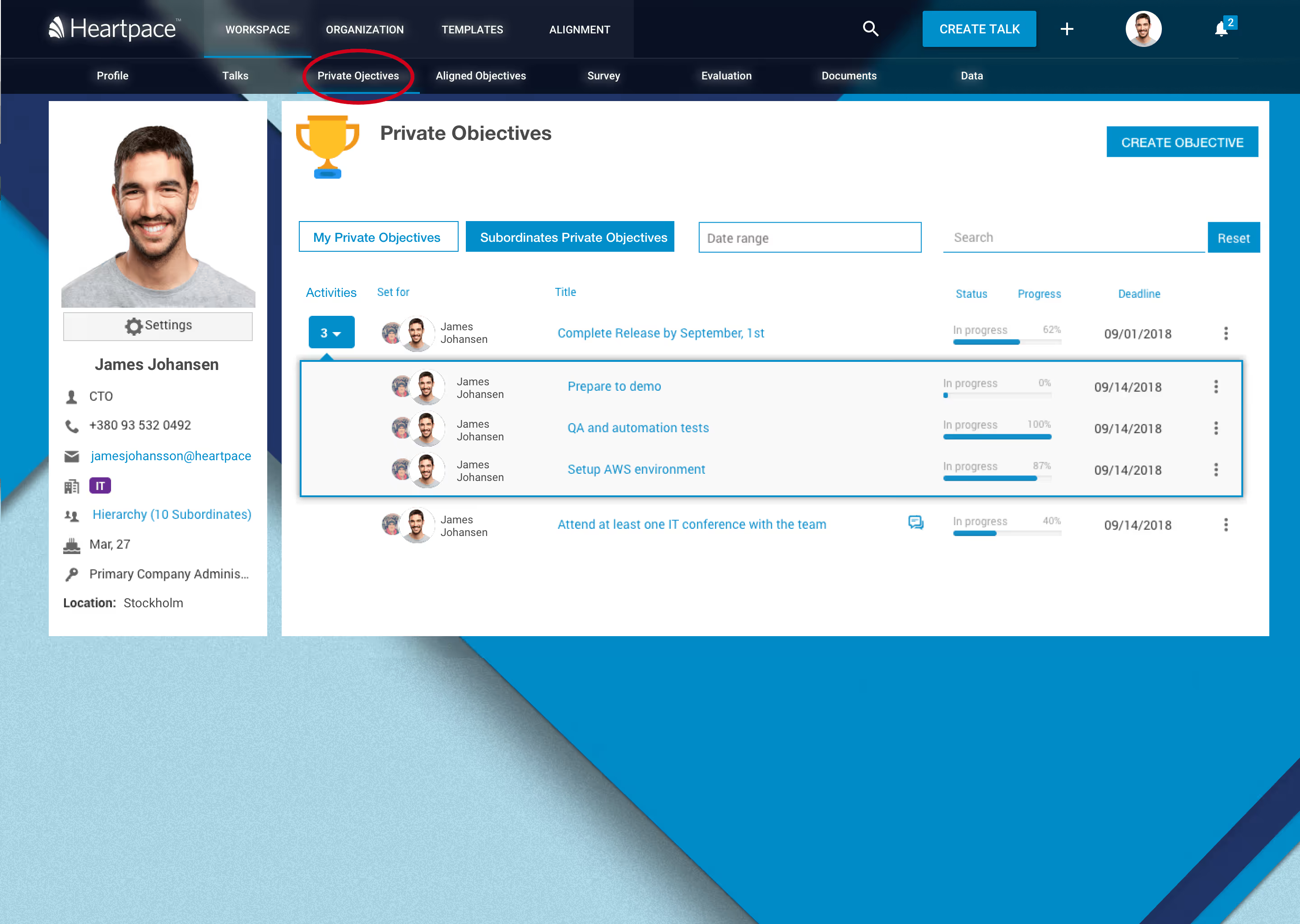
Heartpace is an HR system that focuses on empowering businesses to make the right decisions based on data-driven insights. It includes modules for HR Management, Performance Management, Pay Management, and People Analytics. The Performance Management module is where OKRs come to play, with features for goal management, continuous feedback, monitoring and development.
Pros
- Simple to use: Reviewers say the platform allows them to evaluate and manage performance in a simple and comfortable way that users can easily understand.
- Facilitates repetitive tasks: What people like the most, is how this software helped them automate manual, administrative, and repetitive tasks within their HR processes so they can save time and focus on things that provide more value.
- Great feedback features: Heartpace allows HR teams and staff to see the complete employee lifecycle in one place. Features like surveys, talks, 360° evaluations, and OKR tracking allow a more complete view of the employees’ career paths through time.
Cons
- Mobile application not available: We can imagine the Heartpace team is working on this already, but the software is not mobile-friendly yet. This can be challenging for people used to track their goals and performance on the go.
- Few reviews: G2Crowd and Capterra show very few reviews for this software, so you’ll need to dig deeper into other sites to get more information before you make your decision.
- HR focus: If you’re looking for an OKR tool for employee performance, this is a great choice, but if you want to focus on your business strategy, then you’ll need other functionalities.
Pricing
Pricing is not provided on their website; you’d need to book a demo with their team to find out.
Which OKR Solution Should You Choose? 👀
Go for a tool that'll grow with your organization’s needs and won’t lock you into the OKR framework if you decide it no longer fits with your processes.
Hopefully, we've provided some insights and tips to help you figure out which OKR tool is right for you.
Our recommendation? Cascade. Yes, we might be biased since Cascade is our tool, but customer reviews back up our claims with 4.8-star ratings.
Its ease of use and features make goal management, progress tracking, and complete visibility easy for startups, mid-sized businesses, and enterprises.
Plus, thanks to its flexibility, you don’t have to stick with the OKR methodology if you choose to use other goal-setting and strategy execution frameworks.
👉🏻 Want to see Cascade in action? Book a free product tour with one of Cascade’s strategy experts.
Editor’s note: We’ve done our best to give an honest overview of all the great tools that are out there. If you spot a mistake, please let us know.
FAQs
What Are OKRs?
OKRs (Objectives and Key Results) is a goal-setting framework used in organizations for performance management. Objectives are high-level goals, while Key Results are measurable milestones. Great OKRs promote transparency, alignment, and accountability by providing a roadmap and measurable metrics for progress.
📚Recommended read: How to track OKRs, so you make consistent progress toward your goals.
What is an OKR Software?
An OKR software is a digital tool or platform designed to help organizations in implementing and managing the OKR framework. It provides a centralized platform for creating, tracking, and monitoring company OKRs at various levels, such as organization-wide, team-specific, and individual objectives.
OKR management software typically offers features like goal setting, progress tracking, alignment visualization, collaboration tools, and reporting capabilities. These tools make it easier for teams and individuals to define objectives, set key results, update progress, and communicate effectively across the organization.
What’s the difference between OKRs and KPIs?
OKRs (Objectives and Key Results) set qualitative goals with measurable milestones, while KPIs (Key Performance Indicators) measure specific metrics for performance assessment. OKRs are more flexible and promote alignment, while KPIs focus on monitoring specific areas of performance.

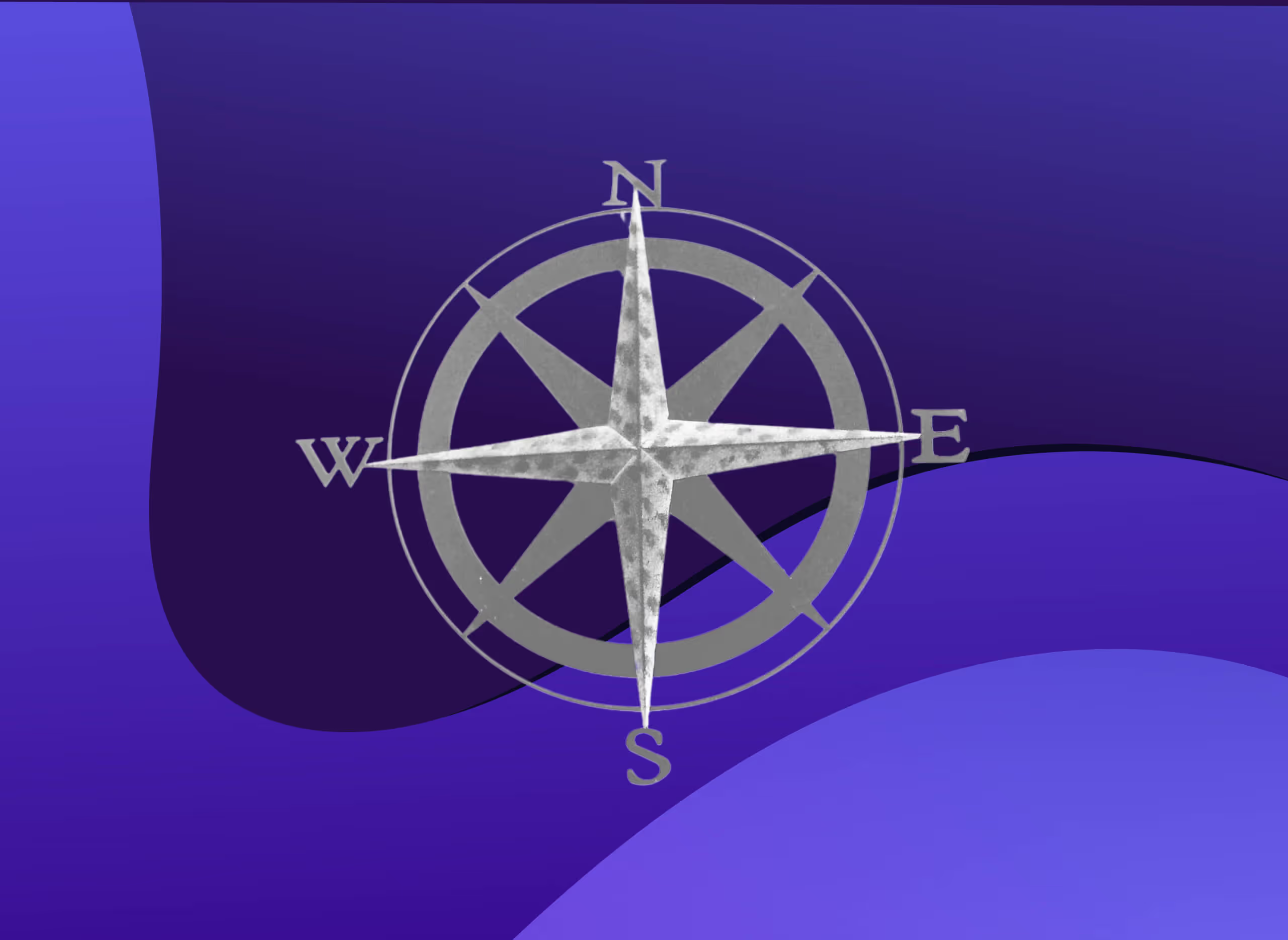



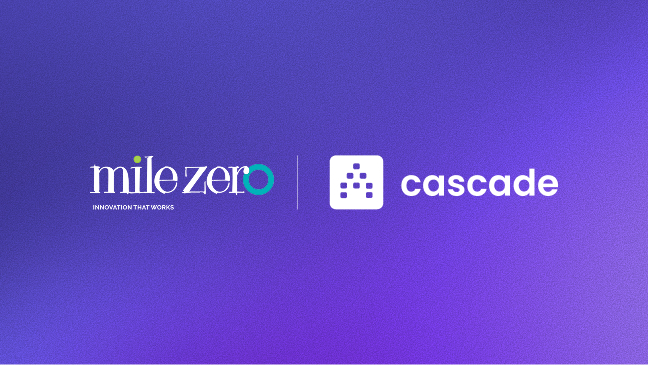
.png)
.jpg)
.jpg)



